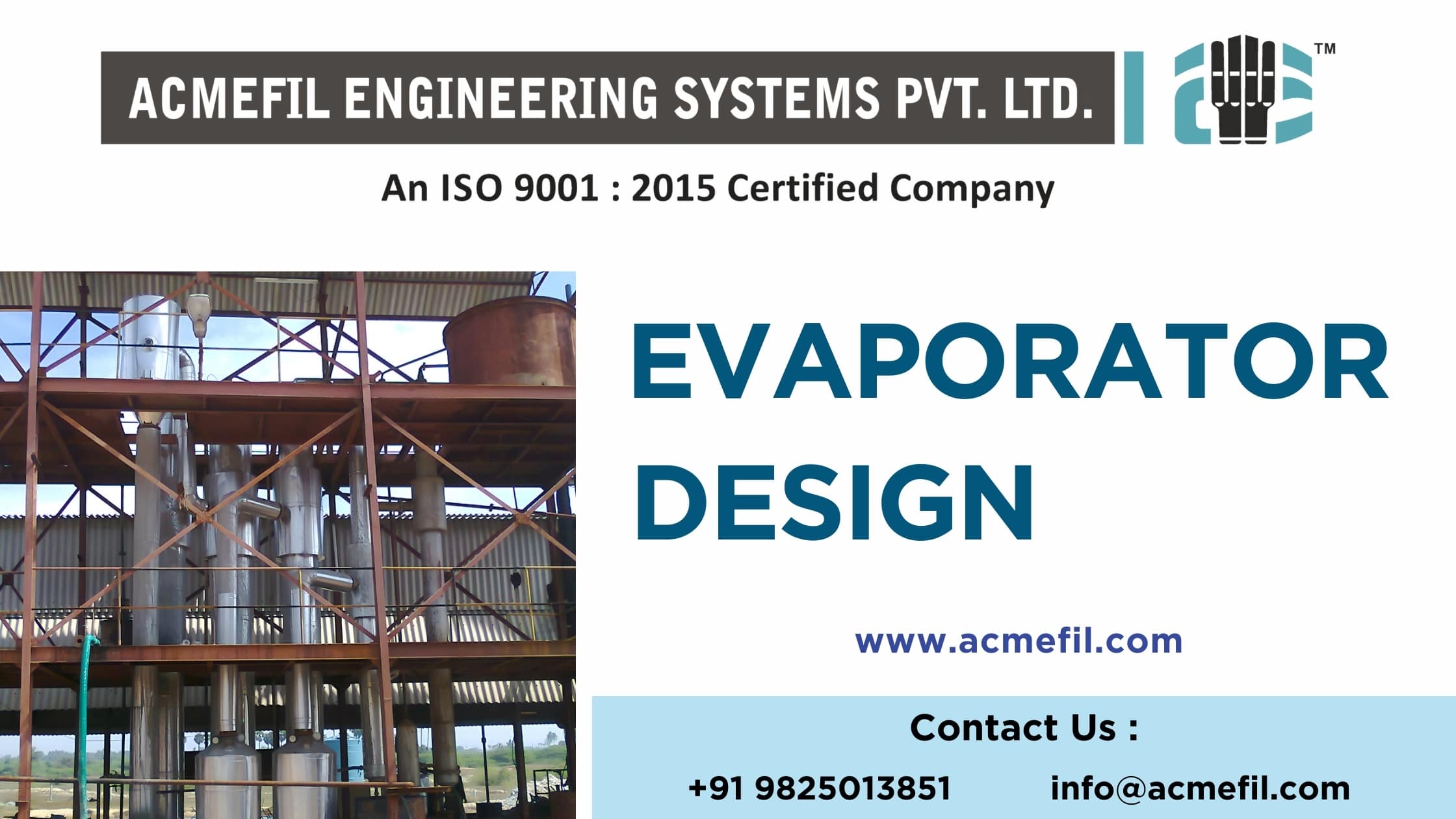Evaporators play a crucial role in various industrial processes, providing efficient solutions for concentrating and purifying liquids. At Acmefil Engineering Systems Pvt. Ltd., we design and manufacture a wide range of evaporators tailored to meet specific client needs. This comprehensive guide covers different types of evaporator designs, including falling film evaporators, agitated thin film evaporators, ammonia evaporators, calandria evaporators, single and multi-effect evaporators, evaporator coil designs, flash evaporators, thin film evaporators, vacuum evaporators, and wiped film evaporators. Each section highlights the key aspects of these designs, ensuring a thorough understanding of their functionality and applications.
About Acmefil Engineering Systems Pvt. Ltd.
Acmefil Engineering Systems Pvt. Ltd. leads the industry in designing, manufacturing, and supplying advanced evaporation systems. With decades of experience and a commitment to innovation, we provide cutting-edge solutions to clients across various industries, including food processing, pharmaceuticals, and chemicals. Our dedication to quality and customer satisfaction has established us as a trusted name in the industry.
Evaporator Design: An Overview
Evaporator design involves engineering systems that efficiently separate solvents from solutes by vaporizing the solvent. The specific requirements of the process, such as the nature of the liquid, the desired concentration, and the thermal sensitivity of the product, determine the choice of design.
Types of Evaporator Designs
Falling Film Evaporator Design
Falling film evaporators efficiently evaporate heat-sensitive liquids. In this design, the liquid flows as a thin film down the inner surface of a vertical tube. Heat applied to the outside of the tube causes rapid evaporation of the liquid. Key features of falling film evaporator design include:
- Efficient Heat Transfer: The thin film maximizes the surface area for heat transfer.
- Low Residence Time: This design is ideal for heat-sensitive products due to minimal exposure to heat.
- Scalability: Falling film evaporators suit large-scale operations thanks to their efficient design.
Agitated Thin Film Evaporator Design
Agitated thin film evaporators, also known as wiped film evaporators, handle high-viscosity liquids and heat-sensitive materials. The design includes a rotating wiper system that continuously agitates the liquid film, enhancing heat transfer and preventing fouling. Key aspects of agitated thin film evaporator design include:
- Continuous Agitation: This ensures uniform heat distribution and prevents buildup on the surface.
- High Efficiency: The design suits the processing of viscous and fouling-prone liquids.
- Flexibility: It can handle a wide range of feed viscosities and compositions.
Ammonia Evaporator Design
Ammonia evaporators optimize the heat exchange process for ammonia, a common refrigerant, in refrigeration and industrial cooling applications. Important features of ammonia evaporator design include:
- Corrosion Resistance: Materials and coatings prevent ammonia-induced corrosion.
- Efficient Heat Exchange: The design maximizes the surface area for effective heat transfer.
- Safety: Design considerations ensure the safe handling of ammonia, including pressure relief systems.
Calandria Evaporator Design
Calandria evaporators are widely used in the sugar industry and other applications requiring efficient evaporation. This design features a cylindrical vessel with vertical tubes through which the liquid flows, heated by steam. Key elements of calandria evaporator design include:
- High Efficiency: A large heat transfer area ensures rapid evaporation.
- Compact Design: It suits installations with limited space.
- Versatility: The design can be used for various applications beyond the sugar industry.
Design of Single Effect Evaporator
Single effect evaporators suit processes where a single stage of evaporation suffices. The design involves a single evaporating vessel where the liquid is heated and vaporized. Key considerations in the design of single effect evaporator include:
- Simplicity: The straightforward design makes it easy to operate and maintain.
- Cost-Effective: Lower initial investment compared to multi-effect systems.
- Specific Applications: It suits processes with low throughput requirements.
Design of Multi Effect Evaporator
Multi effect evaporators provide energy-efficient evaporation by utilizing multiple stages or effects. Each stage operates at a progressively lower pressure, reusing the vapor from the previous stage as a heat source. Key aspects of the design of multi effect evaporator include:
- Energy Efficiency: This design significantly reduces energy consumption by reusing heat.
- High Throughput: It suits large-scale operations requiring extensive evaporation.
- Complexity: Careful design and control ensure optimal performance.
Evaporator Coil Design
Evaporator coils are crucial in HVAC and refrigeration systems, responsible for the heat exchange process. The design of evaporator coil focuses on maximizing heat transfer efficiency. Important features of evaporator coil design include:
- Fin and Tube Arrangement: This arrangement maximizes the surface area for heat transfer.
- Material Selection: Durable and corrosion-resistant materials are used.
- Airflow Management: The design facilitates efficient airflow over the coils.
Evaporator Coil Circuit Design
Evaporator coil circuit design involves arranging and connecting multiple coils to achieve the desired heat transfer and cooling performance. Key considerations in evaporator coil circuit design include:
- Circuit Configuration: Parallel or series arrangements optimize performance.
- Refrigerant Flow Control: This ensures uniform distribution of refrigerant across all coils.
- Pressure Drop Management: The design minimizes pressure losses for efficient operation.
Flash Evaporator Design
Flash evaporators rapidly vaporize a liquid by reducing its pressure. This design is commonly used in desalination and chemical processing. Key elements of flash evaporator design include:
- Pressure Control: Precise pressure reduction ensures effective flash evaporation.
- Heat Exchange Efficiency: The design maximizes the surface area for rapid heat transfer.
- Robust Construction: It handles high-pressure differentials.
Thin Film Evaporator Design
Thin film evaporators handle heat-sensitive and viscous materials by creating a thin film of liquid on a heated surface. This design is similar to agitated thin film evaporators but without the agitation. Key features of thin film evaporator design include:
- Efficient Heat Transfer: The thin film maximizes the surface area for heat transfer.
- Low Residence Time: This design is ideal for heat-sensitive products due to minimal exposure to heat.
- Versatility: It suits a wide range of applications.
Vacuum Evaporator Design
Vacuum evaporators operate under reduced pressure, lowering the boiling point of the liquid and enabling efficient evaporation at lower temperatures. Key aspects of vacuum evaporator design include:
- Energy Efficiency: Reduced operating temperatures save energy.
- Heat-Sensitive Products: The design suits processing products sensitive to high temperatures.
- Process Control: Precise control of vacuum levels and temperature ensures optimal performance.
Wiped Film Evaporator Design
Wiped film evaporators, also known as agitated thin film evaporators, handle high-viscosity and heat-sensitive liquids. The design includes a rotating wiper system that continuously agitates the liquid film, enhancing heat transfer and preventing fouling. Key features of wiped film evaporator design include:
- Continuous Agitation: This ensures uniform heat distribution and prevents buildup on the surface.
- High Efficiency: The design suits processing of viscous and fouling-prone liquids.
- Flexibility: It can handle a wide range of feed viscosities and compositions.
Conclusion
Acmefil Engineering Systems Pvt. Ltd. delivers top-notch evaporation solutions catering to diverse client needs. Our expertise in designing and manufacturing various types of evaporators ensures customers receive the most efficient and reliable equipment available. By understanding the components and functionality of each evaporator design, you can appreciate the precision and engineering excellence in every evaporator we produce.
For more information about our evaporators and other industrial solutions, please visit our website and contact our team of experts.


